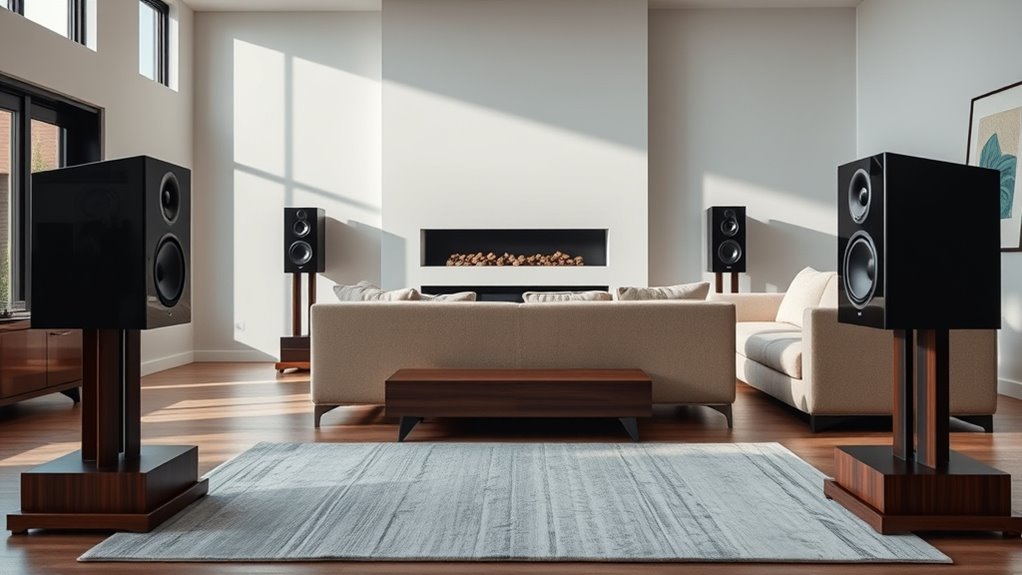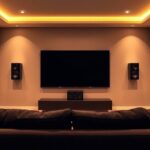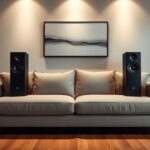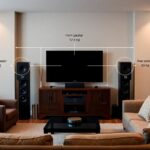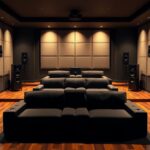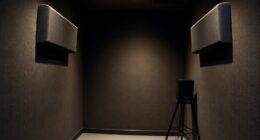To get the best sound, start by positioning your speakers at ear level and forming an equilateral triangle with your listening spot. Keep them away from walls and furniture to avoid distortion. Symmetry is key—make sure left and right speakers are evenly spaced and aligned. Experiment with subwoofer placement near walls for better bass. Proper calibration and testing help fine-tune your setup. If you want to optimize your system further, there’s more to discover below.
Key Takeaways
- Position front speakers at ear level, forming an equilateral triangle with the listening spot for optimal stereo imaging.
- Place subwoofers near walls or corners to enhance bass response without muddying sound.
- Ensure symmetry by placing left and right speakers at equal distances from the listening position.
- Keep speakers away from walls and furniture to reduce reflections and sound distortion.
- Use calibration tools and test tracks to fine-tune speaker placement for balanced, clear audio.
Understanding Room Acoustics and Its Impact on Sound
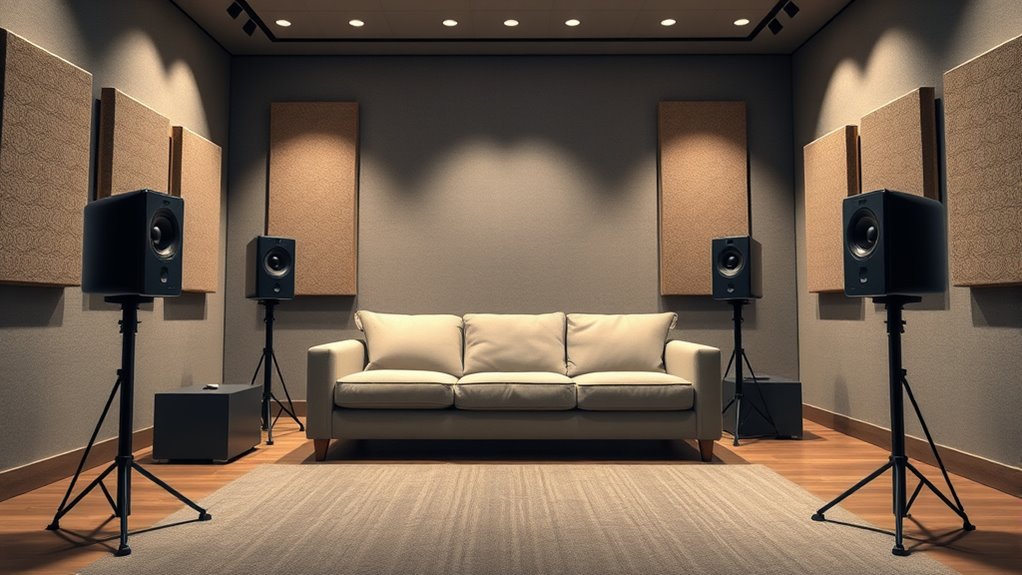
Have you ever wondered why some rooms sound better than others? It all comes down to room acoustics and how sound waves behave inside the space. When sound waves hit surfaces, they reflect, creating sound wave reflection that can enhance or muddy the audio. Room size plays a vital role—smaller rooms tend to amplify reflections, leading to echo and muddiness, while larger spaces allow sound to disperse more evenly. The shape and materials of your walls also influence how sound waves reflect, affecting clarity and bass response. Understanding these factors helps you optimize your setup, reducing unwanted reflections and ensuring a balanced, clear sound experience. Adjusting your space or adding acoustic treatment can dramatically improve how your speakers perform. Additionally, considering the contrast ratio of your audio environment can help in achieving optimal sound clarity and depth. Recognizing the importance of room acoustics is essential for creating an ideal listening environment, and being aware of sound wave reflection can further refine your setup for better audio quality.
Strategic Placement for Stereo and Surround Sound Systems
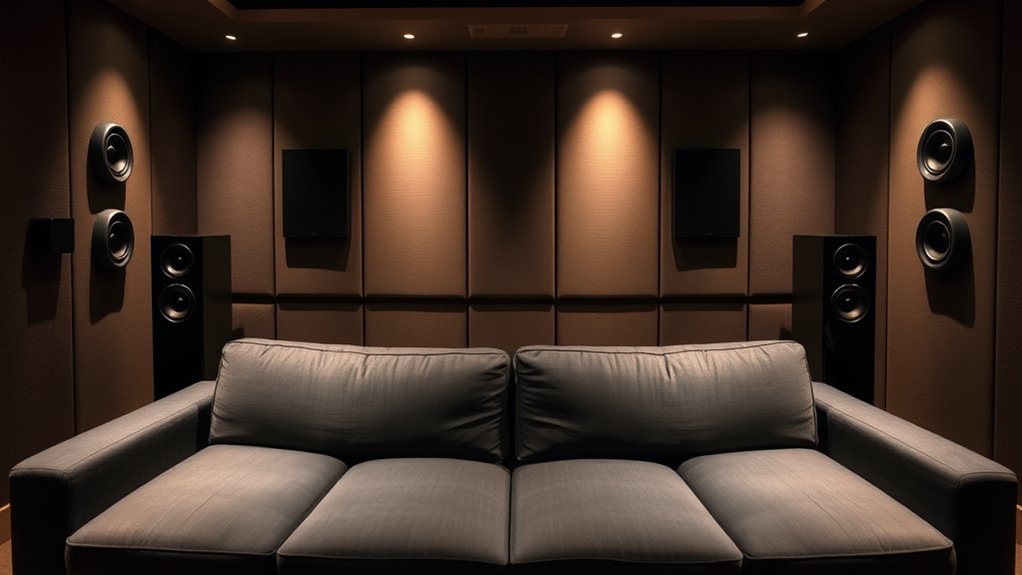
Proper placement of your stereo and surround sound speakers is essential for achieving balanced, immersive audio. Start by positioning your front left and right speakers at ear level, forming an equilateral triangle with your listening spot. For ideal subwoofer integration, place the subwoofer near a wall or corner to enhance bass response without muddying clarity. Surround speakers should be placed slightly behind and to the sides, angled toward your listening position. To prevent sound bleed, ensure speaker isolation by keeping each speaker away from walls and furniture that could distort sound. Visualize this setup as: 1. Front speakers framing your TV or projector screen 2. Surrounds positioned just behind and to the sides 3. Subwoofer tucked near a wall for deep, controlled bass. Additionally, consider speaker placement guidelines from reputable audio resources to optimize your setup. Proper speaker positioning also helps reduce sound distortion and improves overall audio clarity, making your listening experience more enjoyable. Incorporating knowledge from Kia Tuning can also inspire creative customizations to enhance your vehicle’s audio system for a more personalized sound experience. Furthermore, paying attention to acoustic treatments in your room can significantly improve sound quality and clarity, especially when combined with reliable soundproofing techniques.
The Importance of Speaker Height and Ear Level Alignment
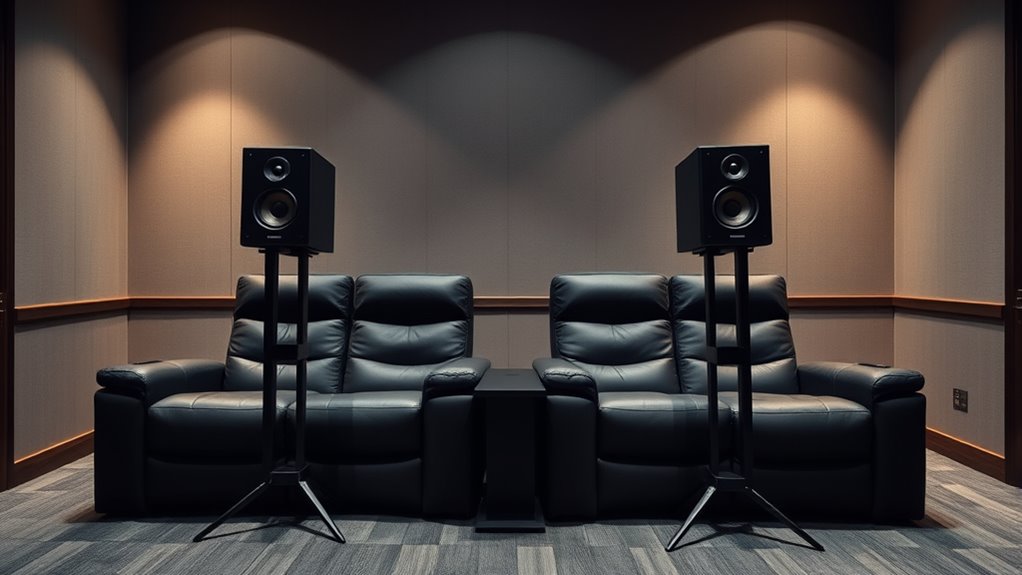
Ensuring your speakers are at the right height and aligned with your ear level makes a significant difference in your listening experience. Proper speaker height helps deliver clear, balanced sound by directing audio directly toward your ears. When speakers are too high or too low, the sound can become muddled or uneven, reducing clarity and immersion. Adjusting the speaker height to match your ear level guarantees you hear the full range of frequencies as intended, with better stereo imaging and a more natural soundstage. Whether you’re setting up for music, movies, or gaming, aligning your speakers to ear level creates a more accurate and engaging listening environment. Remember, small adjustments in speaker height can dramatically improve sound quality and your overall enjoyment. For optimal results, consider speaker placement guidelines to maximize audio performance. Additionally, paying attention to listening environment can further enhance your audio experience. Proper speaker height is essential for achieving the best possible sound clarity and immersion, especially in listening environments where room acoustics can influence sound quality. Studies on audio perception emphasize that even slight misalignments can significantly impact sound fidelity and listener comfort.
Using Symmetry and Spacing to Achieve Balance
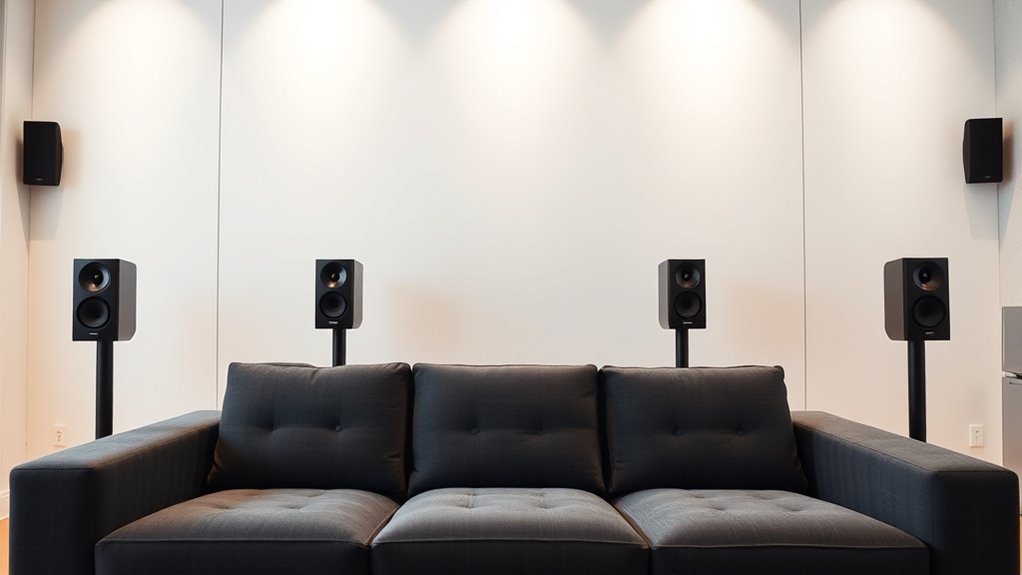
Achieving a balanced and immersive soundstage hinges on using symmetry and proper spacing between your speakers. Start by ensuring speaker symmetry: place your left and right speakers at equal distances from your listening position, creating a mirror image. Next, focus on spacing consistency: maintain equal gaps between each speaker and your ears. Visualize this:
- Imagine two speakers equidistant from you, forming a perfect triangle.
- Picture a straight line connecting both speakers, centered on your listening spot.
- Envision a consistent gap between each speaker and your ears, avoiding any imbalance.
Fine-Tuning Your Setup With Calibration and Testing

Once you’ve set up your speakers with symmetry and correct spacing, the next step is to fine-tune your system through calibration and testing. Proper subwoofer positioning is vital; experiment with placement to achieve deep, balanced bass without boomy or muddy sounds. Use a calibration microphone and an equalizer to adjust volume levels, speaker distances, and tone settings for a cohesive soundstage. Good cable management guarantees your setup remains organized, reducing interference and making future adjustments easier. Testing your system with various audio tracks, listening for clarity, bass response, and stereo imaging, helps identify areas for improvement. Small tweaks in positioning and calibration can considerably improve sound quality, transforming your space into a true listening environment. Additionally, referring to speaker placement guidelines can help optimize your setup further. Being aware of sound frequency response and how it impacts your listening experience allows for more precise adjustments. This process guarantees your speakers deliver their best performance, especially when considering fandom-inspired listening environments that require tailored acoustic arrangements. Regularly updating your calibration based on audio source quality can also enhance overall sound fidelity.
Frequently Asked Questions
How Do I Choose the Right Speaker Type for My Space?
To choose the right speaker type for your space, consider your room size and listening goals. For deep bass, go with a subwoofer and think about ideal placement for it. Match speaker height to the listener’s ear level for clear sound. Larger rooms may need floor-standing speakers, while smaller spaces benefit from bookshelf or wall-mounted options. Always test different types in your space before making a final decision.
Can Furniture Placement Affect Speaker Performance?
Did you know that furniture placement can improve or hinder your speaker performance? You should consider acoustic treatment and furniture arrangement because they influence sound reflection and absorption. Properly positioning furniture away from speakers prevents unwanted echoes, while strategic placement enhances clarity. So, yes, your furniture can substantially impact audio quality, and adjusting it can make your listening experience much better.
What Tools Are Best for Accurate Speaker Calibration?
You should use a sound level meter or calibration microphone with a sound analyzer app for accurate calibration. These tools help you adjust the sound level for consistent volume across all speakers and subwoofer positioning. By fine-tuning with these devices, you ensure balanced sound and peak performance, avoiding muddiness or distortion. Proper calibration enhances your listening experience, making sure your setup delivers clear, even sound throughout your space.
How Does Room Size Influence Speaker Placement Choices?
Imagine the size of your room is as vast as a concert hall or as tiny as a closet. Room size drastically impacts your speaker positioning because larger spaces need careful speaker placement to fill the room with sound, while small rooms demand precise positioning to avoid echo and muddiness. Good room acoustics and strategic speaker placement are essential to optimize sound quality, no matter how big or small your space is.
Are There Common Mistakes to Avoid When Setting up Speakers?
Avoid common mistakes like improper speaker height and poor cable management. Make sure your speakers are at ear level when you’re seated, as this improves sound clarity. Also, keep cables organized and out of the way to prevent tripping hazards and signal interference. Double-check that all connections are secure, and don’t place speakers too close to walls, which can cause unwanted sound reflections. These tips help optimize your setup for better audio quality.
Conclusion
Now that you know the essentials of speaker placement, are you ready to transform your listening experience? With careful planning—considering room acoustics, speaker height, and proper calibration—you’ll enjoy richer, more balanced sound. Don’t settle for mediocre audio; instead, take control and create a setup that truly immerses you. Are you prepared to put these tips into action and elevate your home audio game? The perfect soundstage is just a few adjustments away.
